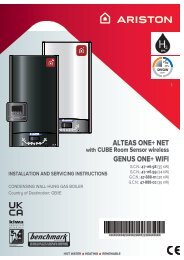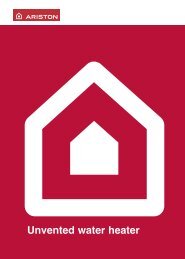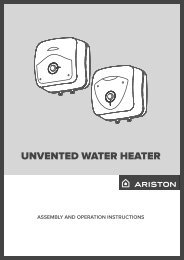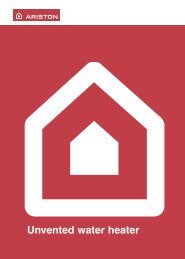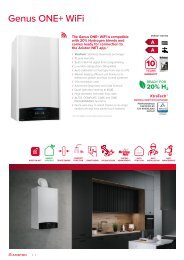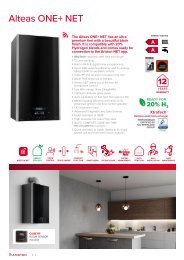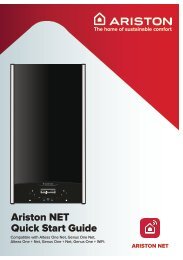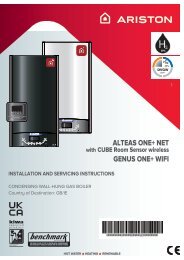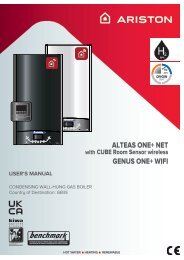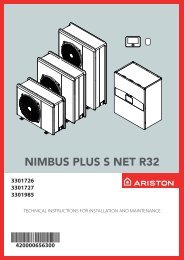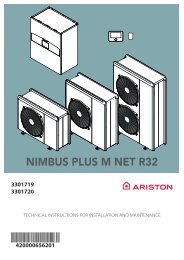Nimbus Compact M NET R32 Installation Manual UK
You also want an ePaper? Increase the reach of your titles
YUMPU automatically turns print PDFs into web optimized ePapers that Google loves.
Description of the system<br />
2.3 Operational limits<br />
The following diagrams show the limits of the heat pump. The<br />
temperature difference between the delivery and return of the<br />
plate heat exchanger must be between 5°C and 8°C.<br />
Operating limits for space heating<br />
Output water temperature (°C)<br />
75<br />
70<br />
65 3<br />
60<br />
55<br />
50<br />
45<br />
40<br />
1<br />
35<br />
30<br />
25<br />
20<br />
2<br />
15<br />
10<br />
5<br />
0<br />
-35 -30 -25 -20 -15 -10 -5 0 5 10 15 20 25 30 35 40 45 50<br />
Outdoor air temperature (°C)<br />
Fig. 15<br />
1 Operation without restrictions<br />
2 Operation of the outdoor unit with possible capacity reduction<br />
3 Operation with back-up heating element necessary<br />
Operating limits for cooling<br />
Output water temperature (°C)<br />
25<br />
20<br />
15<br />
10<br />
5<br />
(10;23)<br />
(10;5)<br />
UF<br />
FC<br />
(43;23)<br />
(43;5)<br />
2.3.1 Compressor frequency table<br />
The maximum allowed frequency varies with the outdoor temperature.<br />
The values shown in the table refer to the following conditions:<br />
– Heating: air temperature < 0°C<br />
– Cooling: air temperature >30°C<br />
NIMBUS M EXT <strong>R32</strong><br />
35 M 50 M 80<br />
M &<br />
M-T<br />
120<br />
M &<br />
M-T<br />
150<br />
M &<br />
M-T<br />
Min frequency [Hz] 18 18 18 18 18<br />
Max frequency (heating)<br />
80 100 90 75 90<br />
[Hz]<br />
Max frequency (cooling)<br />
[Hz]<br />
65 80 70 57 70<br />
2.3.2 DHW Safety device intervention order<br />
To prevent excessively high temperatures and pressure inside<br />
the tank, the indoor unit is fitted with protection and control<br />
devices that will intervene in the following order:<br />
1 Thermostatic control device: this device, consisting of a<br />
sensor positioned on the DHW tank, switches off the heat<br />
source once the programmed set-point has been reached.<br />
2 Energy cut-out device: this device is a manual-reset<br />
thermostat and is positioned on the heating element of<br />
the technical circuit. The thermostat intervenes when a<br />
temperature of 85°C is reached. If it intervenes, it must be<br />
reset manually.<br />
3 Temperature and pressure relief valve: the tank is fitted<br />
with a T&P relief valve that intervenes in case of overtemperature<br />
(90-95°C) or overpressure (7 bar). Whenever<br />
the valve intervenes, the water flow it discharges could<br />
have a very high temperature.<br />
0<br />
0 5 10 15 20 25 30 35 40 45 50<br />
Outdoor air temperature (°C)<br />
UF:<br />
FC:<br />
underfloor heating<br />
fan coil<br />
Fig. 16<br />
Operating limits for indoor unit<br />
The indoor unit is designed for being installed only in indoor<br />
environments in which the following conditions occur:<br />
– Minimum temperature: 5°C<br />
– Maximum temperature: 30°C - R.H. 65%<br />
Operational limits<br />
– Minimum system water temperature: 5°C<br />
– Maximum system water temperature: 70°C<br />
– Cylinder maximum operating pressure: 0.6 MPa (6 bar)<br />
– Maximum inlet pressure of the safety inlet assembly: 1.2<br />
MPa (12 bar)<br />
– Hydraulic circuit maximum pressure: 0.3 MPa (3 bar)<br />
14 / EN







